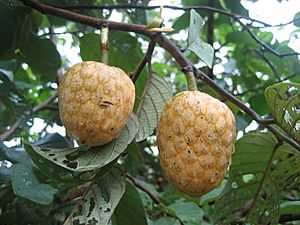African custard-apple facts for kids
Quick facts for kids African custard-apple |
|
|---|---|
 |
|
| Annona senegalensis fruit on a stem, with leaves near Fada N'gourma in Burkina Faso. | |
| Conservation status | |
| Scientific classification | |
| Genus: |
Annona
|
| Species: |
senegalensis
|
The African custard-apple, also known as Annona senegalensis, is a special kind of flowering plant. It belongs to the custard apple family, called Annonaceae. People in different places call it by other names too, like wild custard apple or wild soursop. In the Mandinka language, it's called sunkungo, and in Wolof language, it's dorgot.
The name senegalensis means "from Senegal." This is because the first plant specimen used to describe the species was found in Senegal.
This plant is a traditional food source in Africa. Its fruits can help people get better nutrition and improve food security. It also helps with rural development and supports caring for the land. While it's well-known where it grows, many people elsewhere haven't heard of it.
What it Looks Like
The African custard-apple can be a shrub or a small tree. It usually grows between two and six meters (about 6 to 20 feet) tall. Sometimes, it can even reach up to 11 meters (about 36 feet)!
- Its bark can be smooth or rough. It's usually gray-silver or gray-brown. You might see marks where old leaves used to be.
- New Branches are thick and fuzzy, often gray, brown, or yellow. As they get older, they become smooth.
- The leaves are green to blue-green. They are usually 6 to 18.5 centimeters (about 2.5 to 7 inches) long. The top side is mostly smooth, but the underside can be fuzzy.
- The Flowers are about 3 centimeters (just over an inch) wide. They grow on short stalks, either alone or in small groups. They have six thick petals, which are creamy or yellow. The outside is green, and the inside is creamy or red. The plant usually flowers from April to June.
- The pollen from its flowers stays in groups of four.
- The Fruits are made of many small, bumpy parts joined together. They are oval or round, about 2.5 to 5 centimeters (1 to 2 inches) across. When young, they are green. As they ripen, they turn yellow, then orange. Inside, they are full of orange, oblong seeds.
This plant is usually pollinated by different kinds of beetles. If it's grown as a farm plant, people can also pollinate it by hand. Its seeds usually stay good for about six months.
Where it Grows
The African custard-apple likes to grow in areas near the coast. These places can be dry or a bit humid. It often grows on coral-based rocks with sandy or loamy soils. You can find it from sea level up to 2400 meters (about 7,900 feet) high.
It prefers temperatures between 17 and 30 °C (63 and 86 °F). It also needs a good amount of rain, usually between 700 and 2500 mm (27 to 98 inches) per year. You often see these plants growing alone in woodland savannahs. They also like swamp forests, riverbanks, or old farmland that has been left to rest.
Where it is Found
This plant is native to many parts of tropical Africa. You can find it in eastern, northeastern, western, west-central, and southern Africa. It also grows on islands in the western Indian Ocean.
In South Africa, it grows in KwaZulu-Natal, Limpopo, and Mpumalanga. In Zimbabwe, it is common in the Bikita district.
The African custard-apple has also started growing naturally in parts of India. It is also found on the islands of the Maldives.
How People Use It
The main use for this plant is food. But people use it for many other things too! Almost every part of the plant has special uses.
- Food: The flowers, leaves, and fruit are all edible. The white fruit pulp tastes a bit like pineapple. People add flowers to spice up or decorate meals. The leaves are eaten by humans as vegetables. Livestock also eat the leaves, and they are a favorite food for the West African giraffe.
- Leaves: Besides food, leaves are used to make a health tonic. They can help treat pneumonia. People also use them to stuff mattresses and pillows. In Sudan, people boil the leaves to make perfume.
- Bark: The bark can be used to make a yellow-brown dye. It can also be turned into an insecticide to keep bugs away. People use bark medicine for many problems, like worms in the body, diarrhea, stomach issues, lung infections, toothaches, and even snakebites. A natural sticky substance from the bark can help close open wounds.
- Roots: The Roots are also used in traditional medicine. They can help with dizziness, upset stomachs, and chest colds.
- Other Uses: Young shoots from the base of the plant provide strong fibers for tying things. The soft, pale wood is used to carve tool handles or make poles. The ash from the wood is mixed with chewing tobacco and snuff. It's also used in making soap.
- Oils: The natural oils in the fruits and leaves have special chemicals. These include car-3-ene (in fruit) and linalool (in leaves).
- Skin and Eye Care: Some parts of the plant are used to treat skin problems or eye disorders.
- Traditional Beliefs: Many people in South Africa believe the roots can help with mental health issues. Some people in Mozambique give the roots to babies to help them stop drinking milk from their mothers.
Plant Diseases
Like other plants in the Annona family, the African custard-apple can get a disease called anthracnose. This disease is caused by a tiny fungus called Colletotrichum gloesporioides. It makes the leaves fall off and can cause the fruit to dry up and become hard, like a mummy. To control this disease, people often spray the plants with special treatments.


